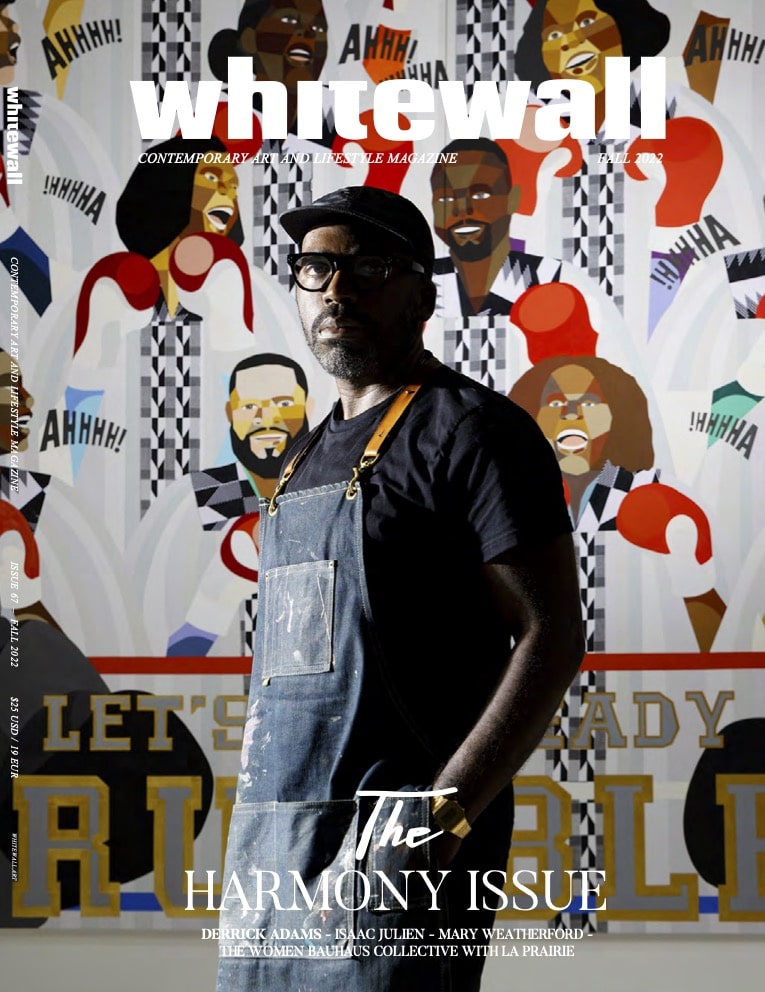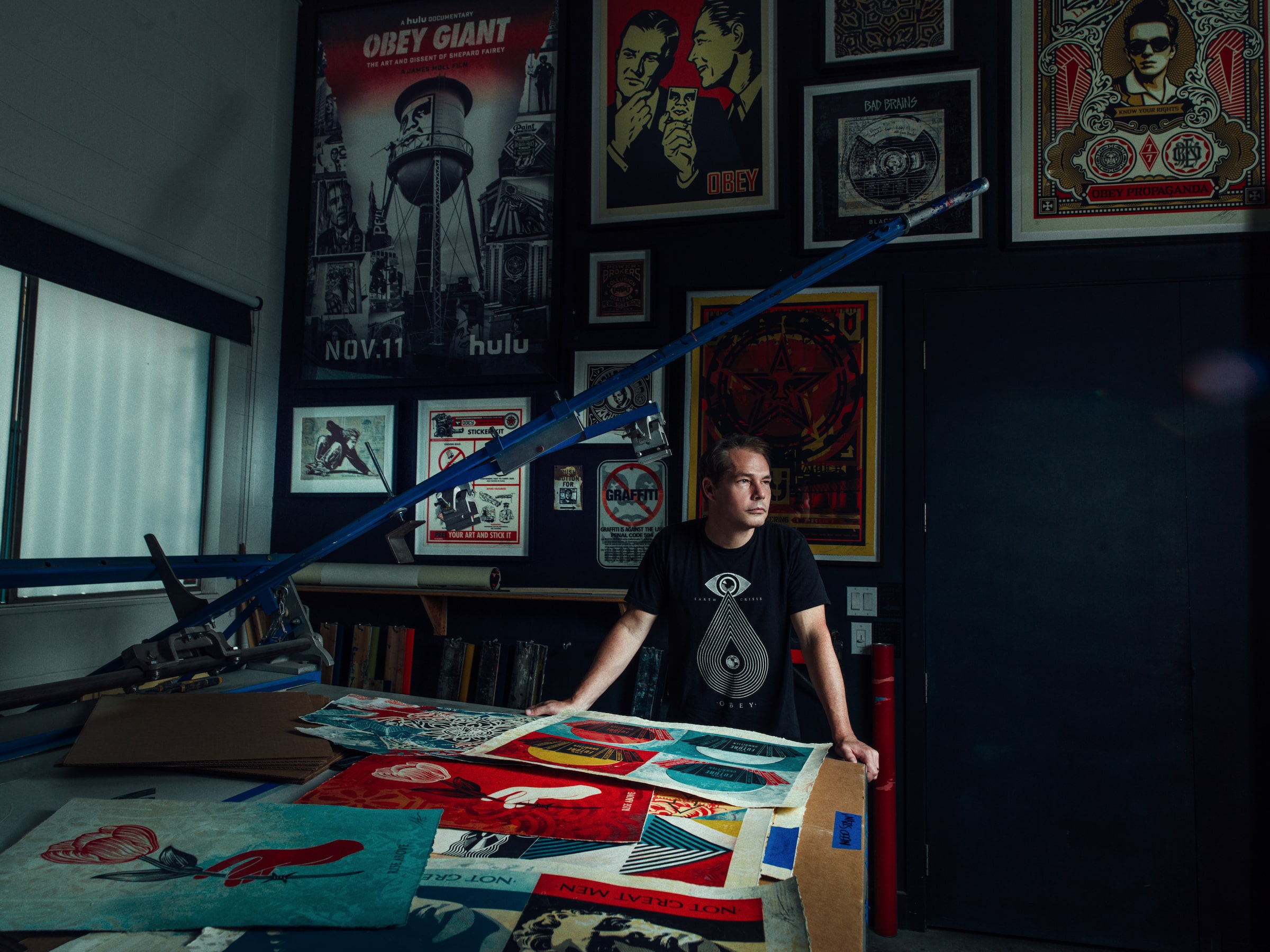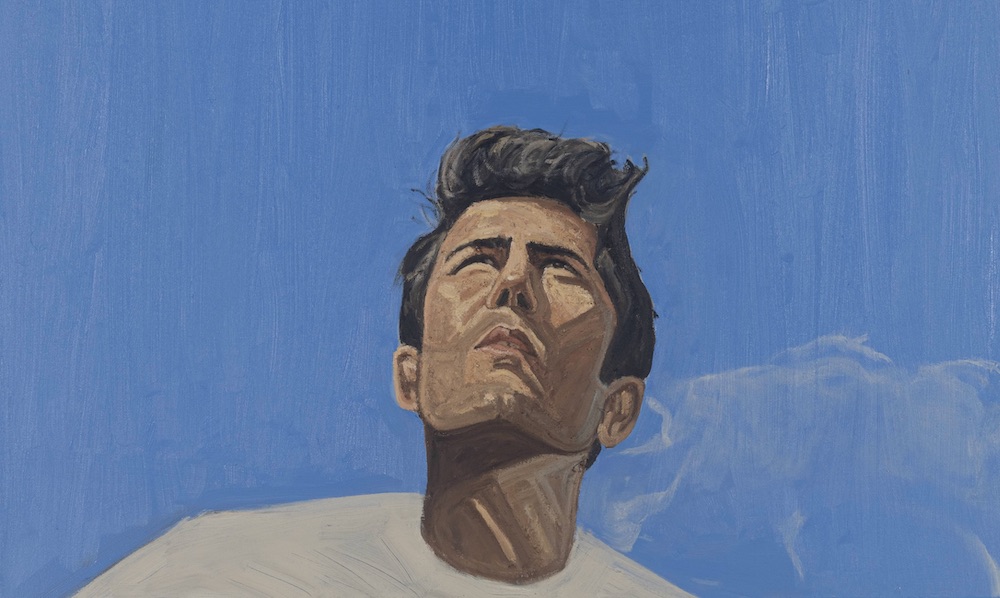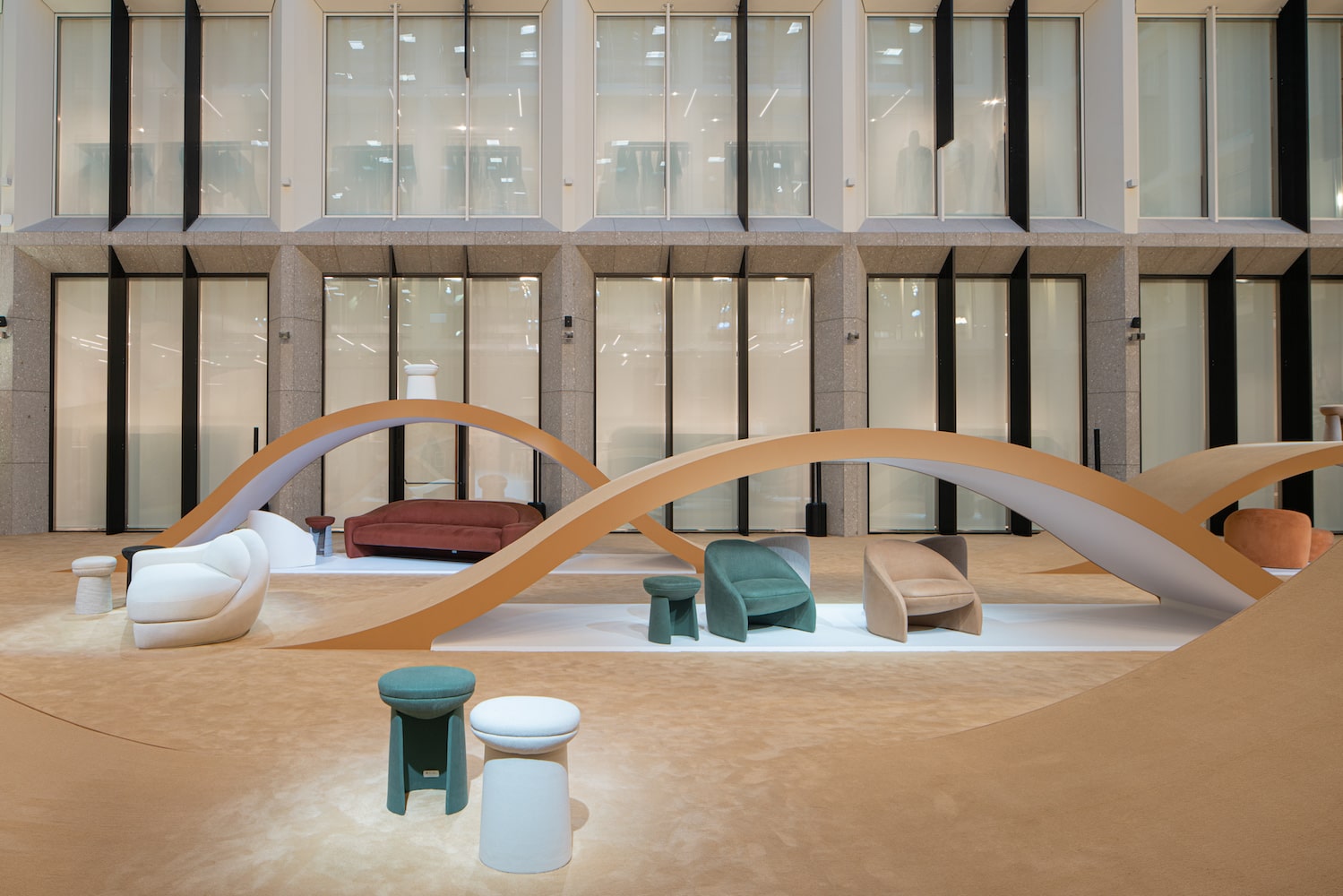A bright white fence gleams against the sun on a residential street in Baltimore. Behind its gate is a large white house with a wraparound porch overlooking a green lawn dotted with black-and-white animal spring riders (like you’d see at a playground), a black talk bubble by Hank Willis Thomas, a colorful mural by Zéh Palito, and a white hanging sign that reads: The Last Resort Artist Retreat.
This is the creative getaway dreamed up by Derrick Adams. After purchasing the property a few years ago, he’s spent time renovating the interior and exterior. As the design came together, he realized it was something he needed to share, imagining a space where artists can come to connect, relax, check out, and recharge. Inside, the serenity of a white palette is welcomingly interrupted by an ever-growing collection of art—photographs by I. Henry Phillips Sr.; prints by Tom Miller, Faith Ringgold, and Glenn Ligon; statement pillows, checkered tablecloths, and vibrant textiles. The atmosphere is communal and familial. This is a space to gather, if that’s what you need.
Adams was born and raised in Baltimore, where he excelled at art from a young age. He moved to New York to pursue his career in the arts, knowing in the 1990s that it was the only place offering the opportunity to do so. If he wanted to be an artist, he couldn’t stay in Baltimore. Always coming back to Baltimore to see his family, he started to notice a few years ago that a younger generation of artists wasn’t feeling the need to leave. They were sticking around and making their own community of working creatives. The idea for what would become The Last Resort started to percolate.
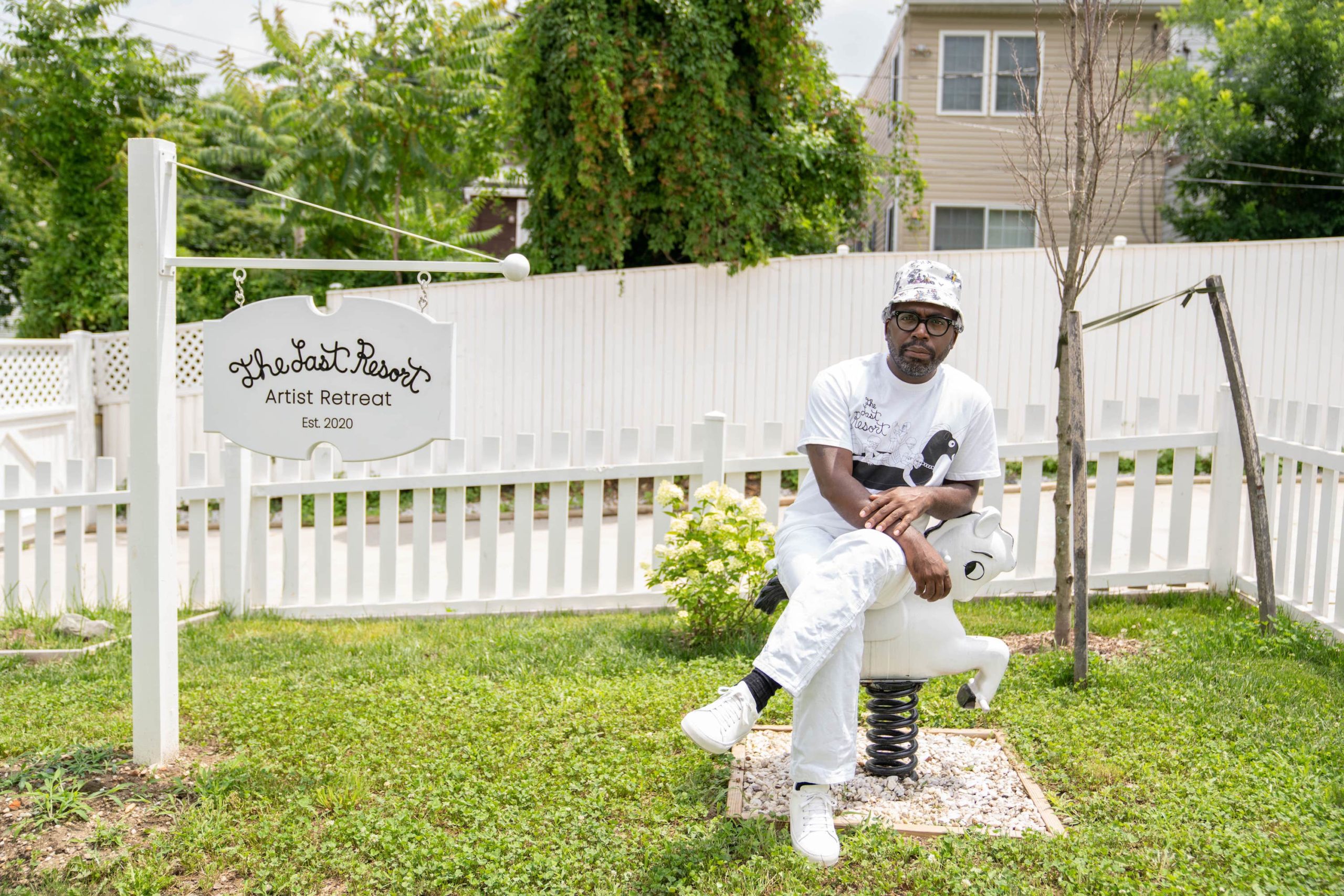
Derrick Adams at The Last Resort Artist Retreat in Baltimore, MD, photo by Shan Wallace.
When we visited Adams in Baltimore in early July, we found him in the kitchen, surrounded by his team and artists like Devin M. Morris, the latter spending a few months this summer in residence. The photographer Shan Wallace was there, too, on assignment to shoot Adams’s portrait for us, but no stranger, stopping by the location from time to time. So far, artists and creatives have been hosted informally, while private events have taken place to celebrate and raise awareness about The Last Resort’s mission. Other endeavors have been more public, like in May, when artists like Ernest Shaw, Megan Lewis, and LaToya Peoples participated in The Last Resort Art Garden at the Pimlico Race Course for the Preakness Stakes.
Adams’s engagement with Baltimore extends beyond the artist retreat, down the block to a site that will become the Black Baltimore Digital Database (BBDD). In the spring, the Andrew W. Mellon Foundation awarded a $1.25 million grant to support the project, a physical space dedicated to cataloging and archiving cultural contributions of Black Baltimoreans. The mission is local, engaging the community via a hybrid real-life and digital space. There will be an archive lab, gallery, screening room, coffee shop,and gift shop, aimed at celebrating and putting into history the significant achievements and contributions of Black citizens of the city.
While walking around the grounds of The Last Resort, Adams—who has upcoming shows at LGDR Hong Kong this fall and the FLAG Art Foundation in New York early next year—told us more about his ambitious plans.
WHITEWALL: How did you get the idea for The Last Resort Artist Retreat?
DERRICK ADAMS: When I first purchased the property, I wasn’t necessarily thinking about a retreat or a residency. I was just interested in having a place to get away when I come to visit my family. I moved in 1993 to New York, but I’ve been coming here often, splitting my time between Baltimore and New York, because my family is here.
After I started carving out spaces and thinking about the design, the layout, I thought, “This property is so nice, I can’t just have it for myself.” How you come to a city like Baltimore really influences your experience of being here. Although there are a lot of people who move into Baltimore from other cities, who are transplants, there is a certain level of Baltimore you cannot access unless you are from here, or at least are immersed in the culture of the city. I am from here so know what people want here. I know what’s missing—offering space without any conditions. That is the idea for the space. I wanted to create a social space for the Black creatives who are central to the city. I think there has never been a space like this where Black people can just come, hang out, and talk.
WW: Were there examples of other residencies or artist retreats you looked to?
DA: I look at Pioneer Works. It is one of the places I love, and I’ve exhibited there. It has a really tranquil, communal space, with an outdoor space where people can just come and hang out. Dustin [Yellin] and Gabriel [Florenz] are really open to the community and to public programming. I love that. We’re not an exhibition space, but we can be a programming space, and we can also create a space where people can just come and hang out.
Communities just want a space to chill, to talk about creative ideas, without having to buy a drink at the bar or order food at the restaurant. Sometimes hanging out for a younger person, especially for a person of color, a Black person in Baltimore, who has very limited funds, is not going to be at a restaurant that is trying to charge the same price for a drink as a New York restaurant. I can create a space where I can host, and have people sponsor the food, the drinks, the music, which creates an atmosphere of comfortability for people to come and share ideas.
The central focus here is on leisure and relaxation. I think that is success right there. Anything else could be a plus, of course. But people don’t have to do anything in order to be valuable here, other than coming with an openness to engage and to have a space of care and consideration.
WW: That alone is radical. When does programming make sense?
DA: When I decided to make it into a retreat, I had to create some kind of leadership structure. That’s when I hired Thomas James, who was at Creative Alliance, who I’d worked with. I think that space is one of growth, and I wanted people that would grow, because we are still forming. Having someone who is flexible, younger, and who understands that social engagement is the key part of the strength of the space, will help a lot with the development and the structuring of the space.
I want everything to be much more in line with processing things. If I had to compare it to a particular organizational structure, in the most grandiose way, I would compare it to the Aspen Institute. If I could create a smaller version of that for the creatives here, that would be the most triumphant achievement. I’ve participated in the Ideas Festival numerous times, and I’ve been there for exhibition purposes, and I was just so amazed at the programming. They brought all these people together to talk—scientists, visual artists, writers, and economists. I want to have a space like that. It’s not really a place to have parties, even though we might have some things here. If you want to be an artist, or if you are a local person that wants to come and read a book, or sit with your headphones and look at art, I want that to be a possibility that is obtainable in some way.
When I grew up here, I didn’t have a space like this at all. But I also know people who want to come to Baltimore and want a place like that, and they don’t know where to go.
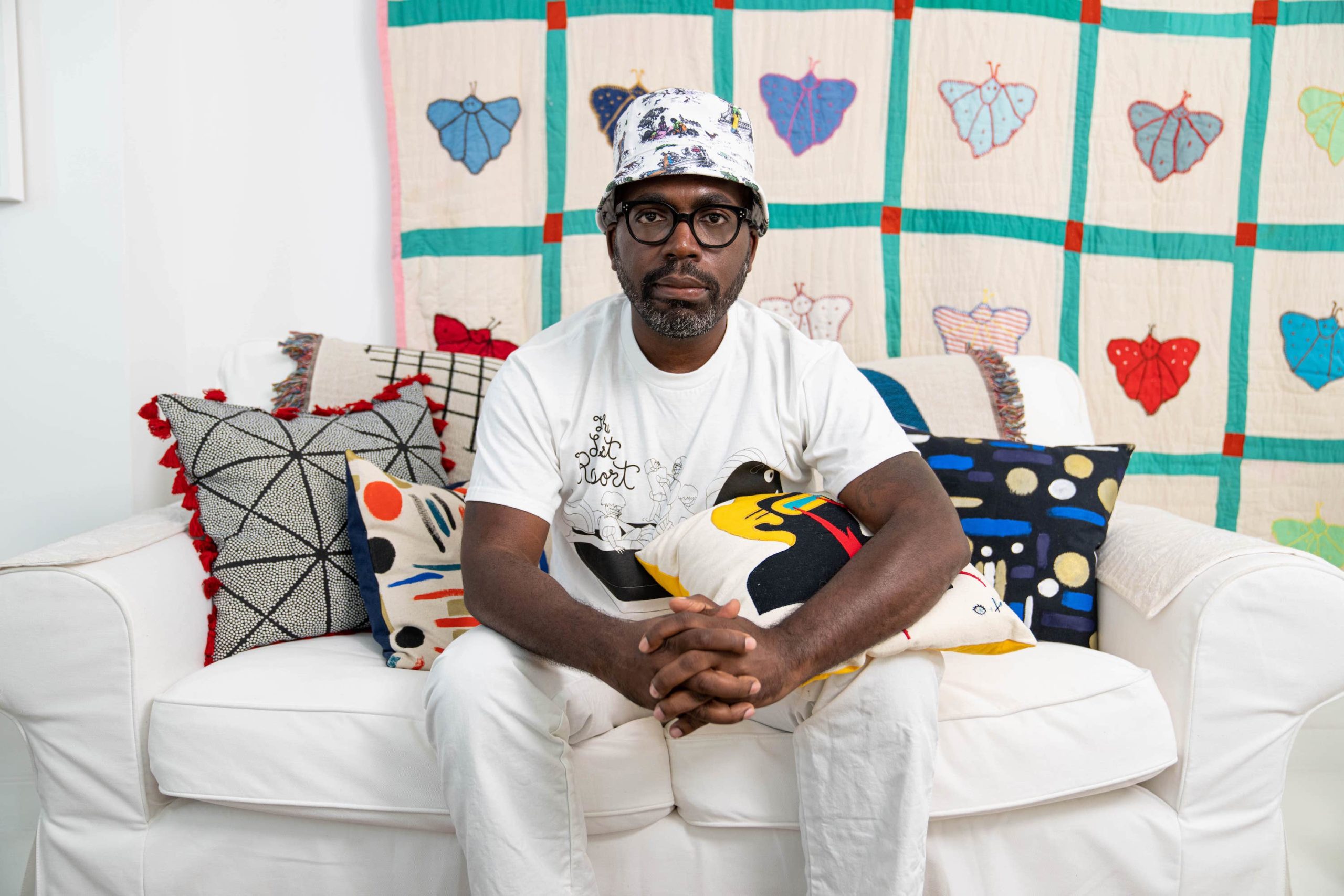
Derrick Adams at The Last Resort Artist Retreat in Baltimore, MD, photo by Shan Wallace.
WW: What do you see this kind of space bringing to Baltimore?
DA: Baltimore is a place where it still has a certain level of community, where you are still connected to the people around you, what they’re doing, and where they are coming from. There is a certain level of authenticity that is here. To me, living in New York and coming back here is always like a wake-up call. Getting off the train, coming to the house, waking up here, and dealing with the politics of the city has been great. The mayor came by two weeks ago. I gave him a tour of the property and told him what I wanted to do, and how I was excited about the possibilities of what could happen in a city like Baltimore, which hasn’t always been the most embracing city when it comes to the creative community. I think Baltimore is just starting to understand the benefits of the creative community.
Baltimore has always had creative people here, but many people have had to leave here in order to flourish in their profession financially. I think there is an opportunity now for people to stay here, but they need a meditating place, and this is that place. What is so cool here is that we have people already tapped in.
The reason why The Last Resort is so significant is that it is really focused around the Black creatives and visual arts, literary, culinary, and even entrepreneurial practices that are spaces that are formed here by artists. In a city where most of the community is Black, if there is a creative person in a creative space, normally they are the only Black person. You realize that you are a minority even within your own city. Having these types of conversations will help strengthen the idea and understanding of this space, and how people navigate this space.
Having this as a home base will allow people to think about themselves as creative people in this bigger picture. It will help sustain them when they are in spaces where they are the only person. When we are here we are not talking about race; we are talking about family, fun, things that we are into like music, fashion, and politics. We are talking about things that people talk about when they are in their familiar space and talking about things they care about.
WW: Outside of being a gathering space for local Black creatives, how does the residency work?
DA: Our goal is to open the space in the beginning of the spring and close the residency at the end of every fall. And in the winter months we are going to keep it open for local people. If they’re working for nonprofit organizations, or coming from the inner city, they can come and use the space as a retreat. They can use the space for brainstorming. There are four people at a time. We have eight rooms, four rooms dedicated to the main residents. The other four rooms will be open for people to come. Those guests who will be here on those one, two, three days will contribute to the diversity. It’s an opportunity to have people who are like-minded in their pursuit of establishing community, but they can offer their insight and experience to the people here. These allies could be from anywhere in the world, people who understand the importance of this type of space and what we are trying to do and are willing to add to that strength of the space. It takes a broad community to develop things in a way that is sustainable and progressive.
We are going to have little activations where people can come to the house. If someone is coming here to John Hopkins to do a talk, or if an artist or a philosopher is coming to town, they will have an extended invitation to stay here, if they like. If they are here, we might have a little dinner for them and invite people from the community to share and talk. If they want to present something, they can, but we will keep it very loose, with social engagement as the anchor of the space and not have it too rigid.
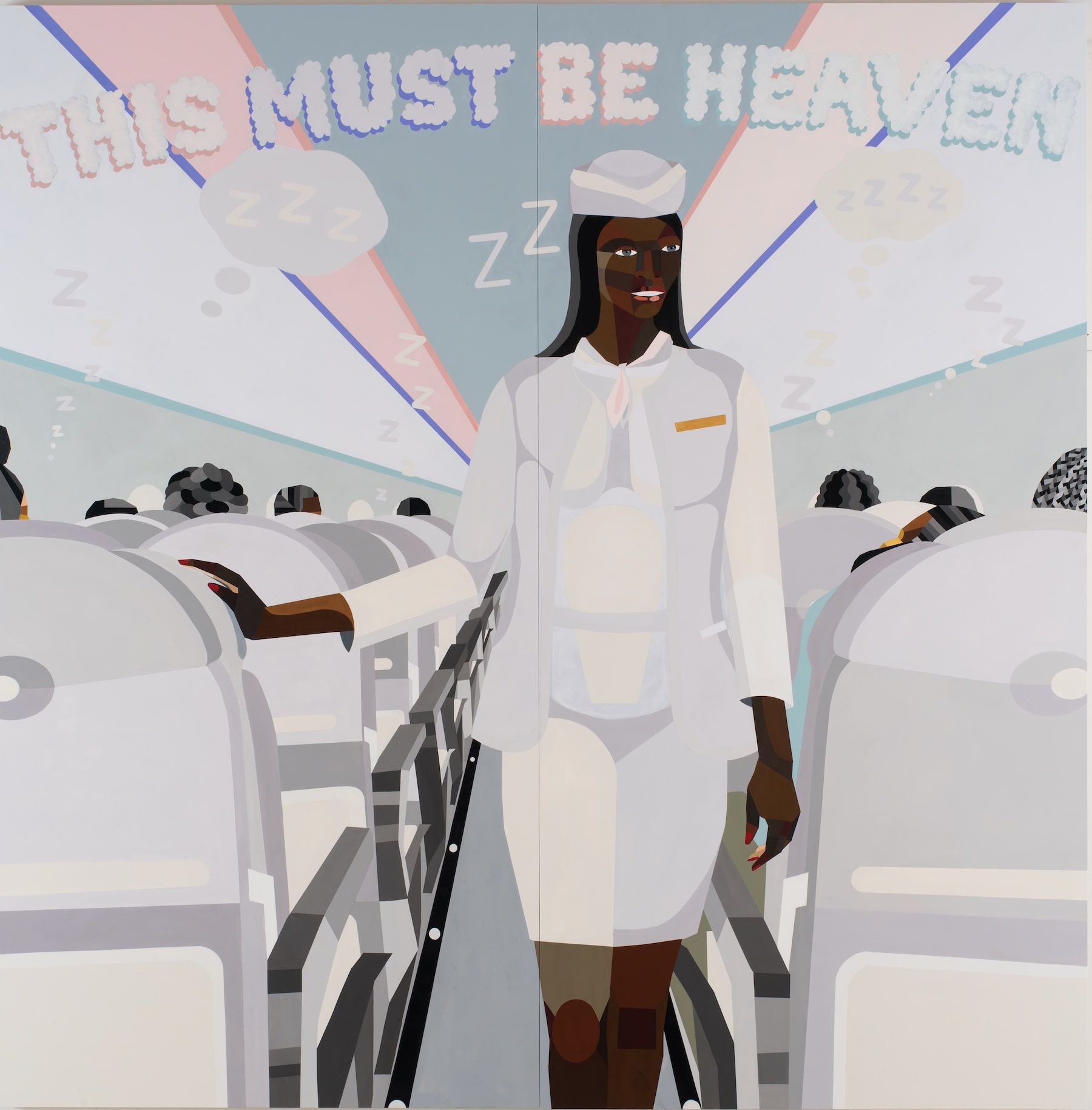
Derrick Adams, “All With a Soft Touch,” 2021, acrylic paint and fabric collage on paper on wood panel, 96 x 94 x 2 inches; courtesy of Derrick Adams Studio @ 2022.
WW: Why is that important, for you, to keep what happens here not too rigid?
DA: It is a space for reconciliation, in some ways. I think that with everything happening in society, dealing with Black people and Black culture, we have still not really had an opportunity to exhale. It seems like such a flippant thing, to have a place where Black people can relax, but Black people really need a break. They need a space to digest what is happening, the things that are happening around us that we can’t really control, that we are trying to reconcile with our level of limitations—political, power, economic. It is not because we are not working hard, but there are forces pushing against our growth that we have to reckon with.
A space like this gives you this feeling of kinship that acknowledges that. The idea of leisure, I believe, or the idea of Black joy as people have coined it, is political. When you think about the strife and constant battles of enforcing that we matter, things that we already know about ourselves—Black Lives Matter. We know we matter. We know our value.
WW: How did you come up with the idea for the Black Baltimore Digital Database?
DA: Everything came about in the last four years. I started doing the show called “Sanctuary,” inspired by the Green Book. With that, I was traveling all around the country, and every time I would go to a different city, if there was a historian in the city, they would reach out to the museum and say, “Can you please bring him to the African American Historical Society.” These places were really neighborhood spaces, either warehouses or spaces people converted. They were never high-end, high-production spaces. And we don’t have a Black Historical Society in Baltimore. I thought, that’s odd. A lot of important Black people come from Baltimore, and there is no space to come and learn about them. We have a Historical Society, but it’s embedded in this larger thing. I feel like we should be highlighted. There are things you need to learn in general—who gets to write history, who gets to document history, and how accurate those histories are?
With The Last Resort, I was thinking about how to create a safe space for Black creative people to come hang out. The database is more public.
WW: So, what will it look like?
DA: We will have Black Baltimore Digital Database down the street, for which we received a grant from Mellon to develop, and now we are hiring an executive director, who will be local.
I want people from here, people who didn’t think that they could find a job doing what they love to do. I want somebody who knows what’s happening on the east side and the west side. There are certain histories here that you might not be interested in unless you are someone who is invested in the city.
The database has become a framing of the space but is not the only draw. It’s a social space, like here, with a database upstairs on the top floor. The bottom floor caters to an exhibition space, a coffee shop, and a local gift shop. There is archiving in cities like Baltimore and Philadelphia within the Black communities at institutions, but the people don’t visit the institution. With the database, the goal is that archivists can say, “I’ve been working in this community, gathering this information. It’s going to Johns Hopkins, but before it goes there. I want to present it at the Digital Database. And I want the people who helped me to secure all of the data to come and talk about the oral history of the concept.” So, people will feel more ownership of the information.
It will be a living archive. If you are an individual who can store information there, you can upload things remotely and create a living archive where you are the author. You can make it public or private. It’s all digitized, and you can keep compiling the data forever. The financial structure is really going into the UX system and constantly updating it. Our responsibility will really be updating the software, making sure that the interface is logical for users who are 80 years old to people who are 10 years old.
WW: You’re telling this community, by offering individual authorship in this archive, that their family, their contributions, and what’s happening in their lives is worth archiving in an institution. That sends a message.
DA: I think that the archive is so important. There is so much information that we may think is important to know, and it might be information that really changes the landscape of the country overall, but it may not be considered information that the general public, or the people who are in control of information, might think is valid.
All those things are valuable. I don’t think we’re at a place where we can kind of edit what is important, so we’re digitizing and letting the community and archivists decide what they think is valuable. I’m not a historian, so I’m not going to be part of the conversation on what is stored and what is not stored, but I would hope that we can have the right people in place to make the best decisions on data.
WW: How has this kind of work, on the retreat and the database, impacted your practice? Can you tell us about your latest pieces?
DA: They are pieces I’ve been working on for the past year and a half, but I have not exhibited them yet. That’s been great, being able to make that work and come back and forth here. It’s not for any particular show; I just had the time to develop this body of work, which I feel really good about. I feel it is my strongest work to date. Coming here while I’m making work has been influential in the outcome of what is being made now. The idea of what I think is important to depict with Black culture, the work really captures it more than it ever has because of my physical presence of being in this space, talking to people, and hearing conversations.
The work became super animated and performative, in a way that I’ve always been interested in, but what you see is another dimension of me as an artist. I think that you really understand where I am now in this work. I’m putting in the work as much as possible, until it’s completely compacted, where nothing else could be said. I wanted to speak differently in every piece. Every piece has a different frequency. Every piece has a different language in some ways that’s not necessarily detouring from the origin. In this particular work, as in all my work, I think about what would Black people want to see when they go to a museum? What would make them feel good? What would make them feel the same level of excitement, and thrill, and overall satisfaction, as a person who is not Black who goes into a museum? I don’t know if Black people need to see trauma at a museum. Trauma is in the media and trauma is everywhere, so I don’t think that Black people need to see more trauma in the leisurely activity of going to see art. It’s not that I want to make things lighter—I want to make things more dimensional.
To truly understand the Black experience in the world and in America, you have to approach it from a multidimensional space and allow Black people the opportunity to enter on their own, to see themselves in a power position, or see themselves in a position of reprise. To bring something into a museum that is more familiar to people gives them the opportunity to have a more reflective experience about things that they may have participated in culturally, that they didn’t think was significant to be in a museum, but now I put in the museum. Barbecues are more than just a barbeque now, or my listening to records is a sort of cultural preservation.
My artwork is about fantasy. But this fantasy also can be tangible. But if you don’t put it out there in the world as an option, then people won’t see it as an option.
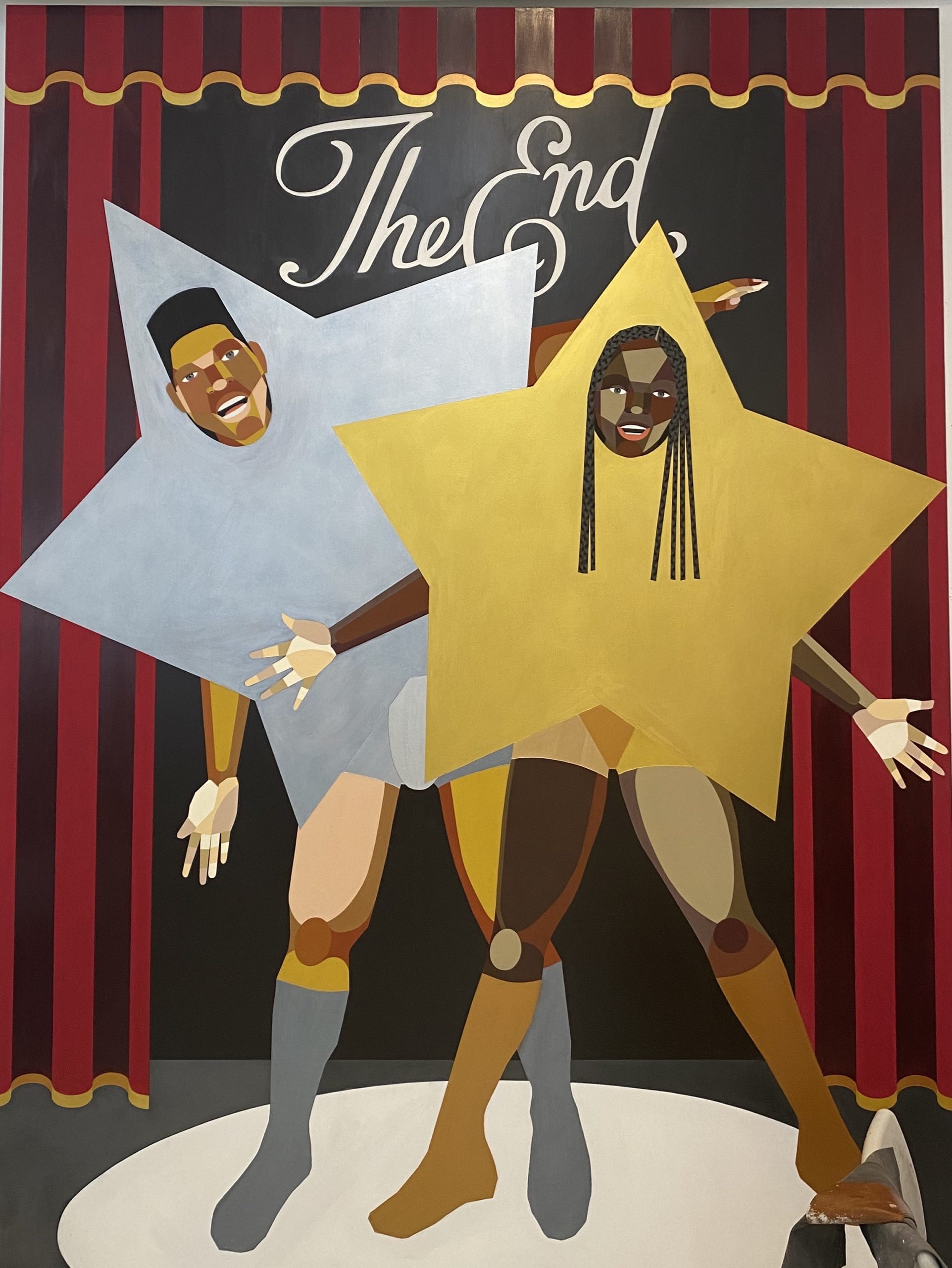
Derrick Adams, “You Just Had to Be There,” 2022, Acrylic paint and fabric collage on paper on wood panel, 96 x 72 inches; courtesy of Derrick Adams Studio @ 2022.


